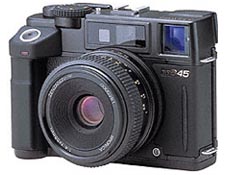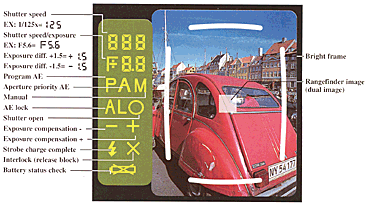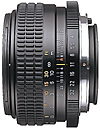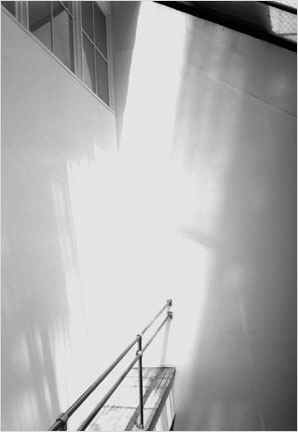A Hands-On Review
By: Mike Johnston

All technical illustrations © Tamron Corporation
This article is based on a posting to theRangefinder List
Completely on-topic for once, I’d like to post a brief report of the newBronica RF645compact rangefinder that I shot with yesterday. I only gave it a quick trial – they had one on display atReimer’sinMilwaukee. I left myLeicahanging hostage from the salesguy’s neck and took theirRF645outdoors for a stroll.
My friendMichael Reichmannposted a comparison of theBronica RF645andMamiya 7on his excellent websiteThe Luminous landscapethat tilted decisively towards the Mamiya. I can understand that – I wrote a full review of theMamiya 6for the oldCamera & Darkroom, briefly owned aMamiya 6, and am very familiar with theMamiya 7. I like them – they’re great cameras – but my own reactions tilted just as decisively, and just as quickly, towards theBronica. I think our different reactions have to do with shooting style. Michael shoots landscape, while I’m more of a people-and-passing-scene type of photographer.Wow–I’ve never actually been able to pigeonhole my style of photography so briefly before. <g>
As a black-and-white negative film shooter, I like everything about 645. My philosophy has always been that the smaller the negative is, the easier the camera is to handle in the field; the larger the negative is, the easier (or perhaps I should just say the more rewarding) it is to make the print in the darkroom. As a shooter of only medium-level skills but a darkroom whiz, I’ve always chosen to go with 35mm – it gives me the advantage where I most need it, and I enjoy (and am up to) the challenge of struggling with the small negatives in the darkroom. The 645 format tilts the balance a bit more towards fine printmaking, without much cost in the field. It’s a nice compromise. It’s also practical – sixteen 645 negs fit on to a single proof sheet, yet are generally large enough to “read” as contacts. I even like the aspect ratio (shape) of the neg. I like the fact that the 645 negative is still small, allowing the use of shorter lenses with better d.o.f. (for roughly the same angle of view on 6×7 as the RF645’s 65mm normal lens, a lens of 80mm focal length is needed). So now you’re aware of all my many prejudices <g>.
Another camera I wrote about for the now-defunctCamera & Darkroomwas theFuji GS645s, a plastic, manual rangefinder 645 I’m sure many of you are familiar with. Like the Fuji, the Bronica’s viewfinder is “turned on end” relative to what 35mm shooters are accustomed to. Its native orientation is vertical. I really liked the oldGS645S’svertical format orientation back when I used that camera. Even when I shoot with 6x6cm square format, I tend to crop to a vertical 645-sized frame much of the time. I find it a natural way to see.Michaelwasn’t pleased with this vertical orientation, since he says 75% of his shooting is horizontal. For me it tips more towards verticals. So my reaction is the opposite of his.
The RF645 is reasonably small and it’s certainly well-balanced. It’s not heavy – about the same weight as aNikon F100(the RF645 is 810g and the normal lens 300g). Just for yuks, I hoisted a full-dressCanon EOS-1vwith the he-man booster pack alternately with the Bronica, and the 35mm Canon was both larger and heavier than the rangefinder. The Bronica has a sizeable handgrip that felt good to me, one that leaves the hand in a comfortable position relative to virtually all the meaningful controls. I was immediately impressed with both the feature-pack and the control layout. Bronica endowed the camera with just about every feature I want in a camera, from aperture-preferred AE to exposure compensation, but they didn’t load down the cameras with fanciness and fripperies that I’d rather not pay for – no laser beams or whirring micromotors or miniature fireworks displays in the finder.
In Control
The controls on the camera back are particularly nice – everything you need within easy reach of the thumb (AE lock and a nifty, handy lever for exposure compensation), with locks only where you need them (on the ISO setting, for instance). Bronica gets high praise for ergonomics. Here are just a few of the nicer features of the RF645 that I noted and approved of:
Lens changing is single-action – no separate film-protection curtain to remember as on the Mamiyas.
The film wind lever, leica Leica, is ratcheted – it can be advanced in a single motion or in several smaller motions.
The lens hood is one of the cleverest I’ve seen. It actually flaresinwardsinstead of out. Added to the already recessed front element of the normal lens, this affords optimal protection both from stay light and from knocks and bumps. This is one lens you don’t need to use a clear protective filter on.
Like theM Leicasand unlike a number of other medium-format rangefinders, the RF645’s rangefinder focusing patch has crisply defined edges. Nice and clean.
The flash sync socket is tucked under the lens in a handy but out-of-the-way position.
The shutter release features a standard cable-release socket. Thank you, Bronica. (And take heed, please, all you other camera manufacturers!)
There are three strap lugs, so the camera can hang either horizontally or vertically.
Lenses, Rangefinder and Viewfinder
A fewnetizenshave commented on the close-focusing distance, a feature of lenses thatHerbert KepplerofPopular Photographyhas been raising peoples’ consciousness about for a number of years now. I didn’t see anything amiss here; close focus is about a meter with the normal lens, which isn’t bad. Rangefinders are just not the proper tools for closeup work, and, because of both parallax and the effective baselength of the rangefinder, longer minimum focus distance is a given – the pre-ASPH35mm Summicronon myM6focuses to arm’s length, for instance, while mySMCP-M Pentax 35/2SLR lens will focus down to mere inches. Imperfect solutions such asVisoflexhousings andDual-Range Summicronswith closeup eyes aside, a relatively longer close-focus distance is a characteristic that’s typical of most, if not all, rangefinders.
Probably the camera’s biggest weakness is that the normal lens is a slow f/4. It would definitely be better if there were at least one normal lens of f/2.8 aperture (possibly there will be in the future – I don’t know, but, sinceBronica’snew corporate parent isTamron, we may not have seen the last of the new lenses for the RF645). But, again, it’s fairly typical – the 80mm for theMamiya 7is an f/4, as is the lens on the littleFuji GS645s. To me the more crucial point would be whether the f/4 aperture is truly usable or not, which, for me, remains to be seen.
A fellow named John Whitman pointed out onphoto.netthat if the rangefinder baselength had been increased, thus allowing faster lenses and closer focusing and making the whole camera larger, more unwieldy, and more expensive, photographers would probably approve of the features but be moaning about size and weight. I think he’s right. At a philosophical level, my position is that there just isn’t such a thing as a “perfect” or perfectly all-purpose camera, and I gave up the search for such a thing years ago. In fact, my opinion has gradually shifted into the opposite point of view. In trying to add capability and features – trying to be all things to all photographers, and, in the process, becoming something they aren’t – otherwise good camera designs sometimes become compromised. A rangefinder is a rangefinder; they’re not the best portrait cameras (although I do a lot of portraits with them) or the best macro cameras – nor, for that matter, would you try to use them for long telephoto work. Bronica makes other cameras for those sorts of things. The RF645 is what it is, and it’s good for what it’s good for. That’s okay with me. I’d rather a camera just go ahead and be good at its principle design brief and play to its basic strengths instead of trying to load up on features and capabilities in a vain attempt to appeal to the broadest possible market segment.

On to the viewfinder. The Canadian magazinePhoto Life, alone among the many magazines which have so far reviewed the RF645, inexplicably gave poor marks for the viewfinder. This has created an instant stain on the camera’s reputation around the internet. That’s a shame…because they’re full of it! I’ve used many different varieties of rangefinder camera in both medium format and 35mm, and the Bronica’s finder ranks right up there among the best. In fact, compared directly to my M6, it scores highly – it’s as bright, while also being less cluttered (with the normal lens, only one set of framelines is displayed – see above), easier to peer into, and as easy to focus. No problem there. A great feature of the RF645 is the viewfinder information. You can read onTamron’s websitewhat-all it shows; what I was concerned with is whether it’s visible, and whether it’s distracting. Well, it is, and it’s not. You see the shutter speed and aperture big, bright, and bold even against a bright sky, but it’s just far enough away from your direct view that it doesn’t impinge on the image area or make an annoyance of itself. This is the best viewfinder information readout on any rangefinder camera that I’m currently aware of. They got this just right.
Shutter Release
The shutter release is something I didn’t get a handle on. It seems a little less razor-sharp in its responsiveness than the best (remember, the camera I’m comparing it to is anM6, peerless in this category). There’s a hint of a “gear-train” kind of feel, as if the shutter is setting off a chain reaction of mechanical events in the camera. However, it appears that the camera does not “dry-fire” – that is, you can’t fire the shutter without having film in the camera. Because I was taking pictures with my film, I didn’t look to see when the shutter actually fires relative to the overall shutter “feel.” It’s possible there’s some slight shutter lag going on, or it’s possible it fires instantly and what I was perceiving as lag is merely the leaf shutter recocking itself after it fires or something like that. I don’t know yet – I’ll have to wait for a more extensive trial before I sort this out.

As far as lens performance is concerned, I can’t comment. The shooting I did will give me some private, seat-o’-the-pants information, but I won’t be willing to make public comments until I’ve given the lens more of a workout. On the plus side, the shutter is very quiet, as you would expect. Off the top of my head, I’d guess it’s not quite as quiet as the Mamiya 7, but in the same league, and it’s quieter than the old Fuji I mentioned, which fires with a sharp “snick.” I have no complaints about the noise level.
I should add that I’m really grateful for the focal length choices on both theMamiya 7and theRF645. Both the 80mm on the former and the normal 65mm on the latter are about equivalent to 40mm on 35mm, far and away my favorite focal length lens on 35. I got turned on to this focal length when I interviewedSally MannforCamera & Darkroom. She mentioned that she used to do professional photography around Lexington, Virginia, where she lives, and that, for her, 40mm seemed “just about perfect.” She had used theOlympus OM Zuiko 40mm f/2, a once very cheap, tiny lens that is now quite rare and sells for a staggering $500 and up, used, when examples occasionally appear oneBay. That lens, along with the40/2 Summicron-Cand40/2 M-Rokkor, subsequently became my favorite lenses. Forty millimeter has got a more relaxed view on 35mm than a 50mm, yet it scrubs off that hint of wide-angly feeling that 35mms have. Some people won’t think this is anything special, or they’ll actively disagree with me, and I won’t argue with them. For me, however, both these normal focal lengths are just to my own taste.

Gallery Space, New York City – By Mike Johnston
In Summary
The whole camera has a decidedly pleasing, well-integrated feel overall. The smoothly-focusing lens connects precisely to the the big, bright rangefinder focusing patch; the lens falls very comfortably to hand. This is an outstandingly easy and comfortable camera to focus. And the overall balance of the camera is great. The easy, very comfortable feeling of the focusing coupled with the big, bright, easy-to-see viewfinder makes the camera seem welcoming and unfussy. The main selling point of theLeica M6to me is that it’s so pleasing to shoot with – it’s just nice to use. It seems to invite you to take it out and play with it. I’m betting the Bronica would share a fair amount of this property. Only time would tell that tale, of course. As has been a tradition with Bronica for many years, value for the dollar is high – for a “suggested street price” of only $1,800 you get both camera and lens, and the associated flash and the other lenses are equally inexpensive. (Try Wisconsin’s little-known but superb resource,Badger Graphic Salesfor a much better prices. How does $200 less than theB&Hprice grab you?) This seems right in line with what I’d want to pay for something less than a studio camera, and compared to other medium-format options it verges on being a steal. Remember that economies of scale don’t factor in nearly as much with medium format, which is a big part of what keeps prices so high. Given this reality, $1,800 is more of a bargain than maybe it appears at first glance if you don’t shoot medium format now – compare prices on medium-format cameras in theB&Hpages inPopular Photographyand you’ll get a better idea how inexpensive the RF645 really is.
Overall, I got a feeling of technology, and especially ergonomics, being atmyservice, instead of being at the service of the sales brochure – like the camera design was deliberately aimed at real, practicing photographers rather than gadget freak camera nuts. I was really pleased and seriously impressed with this little camera. In fact, I liked it so much it took me by surprise – I’ve gotten really good over the years at nitpicking flaws in cameras, as any of my photo-friends will loudly and heartily attest. Granted, rollfilm is a minority format, and rangefinders aren’t everybody’s cup of tea. With those two caveats in mind, the newest Bronica looks like something quite special. I’m just worried about my credit card at this point.
June, 2001 – Mike Johnston
Mike Johnston has a B.F.A. in Photography from theCorcoran College of Art and Designin Washington, D.C., where he was a student of the lateSteve Szaboand ofJoe Cameron.
He was East Coast Editor ofCamera & Darkroommagazine from 1988 to 1994 and Editor-in-Chief ofPHOTO Techniquesmagazine from 1994-2000, where his editorial column “The 37th Frame” was a popular feature and where he presented, among other things, a set of three articles on “bokeh” byJohn Kennerdell,Oren Grad, andHarold Merklingerthat were subsequently widely discussed among photographers.
His critical and technical writings have appeared in various publications and newsletters such asThe Washington ReviewandD-Max. A number of his articles written under the pseudonym “L. T. Gray” (el Tigre) appeared in the English magazineDarkroom User.
This piece is part of an on-going series of articles, reviews and essays written for this site byMike Johnston
publisher ofThe 37th Frame
You May Also Enjoy...
After The Strom – Detail
Please use your browser'sBACKbutton to return to the page that brought you here.
